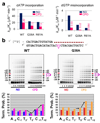Structure and mechanism of human DNA polymerase eta
- PMID: 20577208
- PMCID: PMC2899710
- DOI: 10.1038/nature09196
Structure and mechanism of human DNA polymerase eta
Erratum in
- Nature. 2011 Aug 18;476(7360):360
Abstract
The variant form of the human syndrome xeroderma pigmentosum (XPV) is caused by a deficiency in DNA polymerase eta (Poleta), a DNA polymerase that enables replication through ultraviolet-induced pyrimidine dimers. Here we report high-resolution crystal structures of human Poleta at four consecutive steps during DNA synthesis through cis-syn cyclobutane thymine dimers. Poleta acts like a 'molecular splint' to stabilize damaged DNA in a normal B-form conformation. An enlarged active site accommodates the thymine dimer with excellent stereochemistry for two-metal ion catalysis. Two residues conserved among Poleta orthologues form specific hydrogen bonds with the lesion and the incoming nucleotide to assist translesion synthesis. On the basis of the structures, eight Poleta missense mutations causing XPV can be rationalized as undermining the molecular splint or perturbing the active-site alignment. The structures also provide an insight into the role of Poleta in replicating through D loop and DNA fragile sites.
Figures





Comment in
-
DNA repair: How to accurately bypass damage.Nature. 2010 Jun 24;465(7301):1023-4. doi: 10.1038/4651023a. Nature. 2010. PMID: 20577203 Free PMC article.
Similar articles
-
Structural basis for the suppression of skin cancers by DNA polymerase eta.Nature. 2010 Jun 24;465(7301):1039-43. doi: 10.1038/nature09104. Nature. 2010. PMID: 20577207 Free PMC article.
-
Complementation of defective translesion synthesis and UV light sensitivity in xeroderma pigmentosum variant cells by human and mouse DNA polymerase eta.Nucleic Acids Res. 2000 Jul 1;28(13):2473-80. doi: 10.1093/nar/28.13.2473. Nucleic Acids Res. 2000. PMID: 10871396 Free PMC article.
-
DNA repair: How to accurately bypass damage.Nature. 2010 Jun 24;465(7301):1023-4. doi: 10.1038/4651023a. Nature. 2010. PMID: 20577203 Free PMC article.
-
Replication of damaged DNA: molecular defect in xeroderma pigmentosum variant cells.Mutat Res. 1999 Oct 22;435(2):111-9. doi: 10.1016/s0921-8777(99)00047-6. Mutat Res. 1999. PMID: 10556591 Review.
-
[Mechanisms of targeted frameshift mutations--insertion formation under error-prone or SOS synthesis of DNA containing CIS-SYN cyncyclobutane thymine dimers].Mol Biol (Mosk). 2014 Jul-Aug;48(4):531-42. Mol Biol (Mosk). 2014. PMID: 25842840 Review. Russian.
Cited by
-
Enzymatic bypass and the structural basis of miscoding opposite the DNA adduct 1,N2-ethenodeoxyguanosine by human DNA translesion polymerase η.J Biol Chem. 2021 Jan-Jun;296:100642. doi: 10.1016/j.jbc.2021.100642. Epub 2021 Apr 8. J Biol Chem. 2021. PMID: 33839151 Free PMC article.
-
The structure and duplex context of DNA interstrand crosslinks affects the activity of DNA polymerase η.Nucleic Acids Res. 2016 Sep 6;44(15):7281-91. doi: 10.1093/nar/gkw485. Epub 2016 Jun 1. Nucleic Acids Res. 2016. PMID: 27257072 Free PMC article.
-
Effects of N(2)-alkylguanine, O(6)-alkylguanine, and abasic lesions on DNA binding and bypass synthesis by the euryarchaeal B-family DNA polymerase vent (exo(-)).Chem Res Toxicol. 2012 Aug 20;25(8):1699-707. doi: 10.1021/tx300168p. Epub 2012 Jul 31. Chem Res Toxicol. 2012. PMID: 22793782 Free PMC article.
-
Evidence for the kinetic partitioning of polymerase activity on G-quadruplex DNA.Biochemistry. 2015 May 26;54(20):3218-30. doi: 10.1021/acs.biochem.5b00060. Epub 2015 May 11. Biochemistry. 2015. PMID: 25903680 Free PMC article.
-
Modulation of mutagenesis in eukaryotes by DNA replication fork dynamics and quality of nucleotide pools.Environ Mol Mutagen. 2012 Dec;53(9):699-724. doi: 10.1002/em.21735. Epub 2012 Oct 10. Environ Mol Mutagen. 2012. PMID: 23055184 Free PMC article. Review.
References
-
- Brash DE. Sunlight and the onset of skin cancer. Trends Genet. 1997;13:410–414. - PubMed
-
- Masutani C, et al. The XPV (xeroderma pigmentosum variant) gene encodes human DNA polymerase η. Nature. 1999;399:700–704. - PubMed
-
- Johnson RE, Kondratick CM, Prakash S, Prakash L. hRAD30 mutations in the variant form of xeroderma pigmentosum. Science. 1999;285:263–265. - PubMed
-
- Hishida T, Kubota Y, Carr AM, Iwasaki H. RAD6-RAD18-RAD5-pathway-dependent tolerance to chronic low-dose ultraviolet light. Nature. 2009;457:612–615. - PubMed
-
- Chaney SG, Campbell SL, Bassett E, Wu Y. Recognition and processing of cisplatin- and oxaliplatin-DNA adducts. Crit Rev Oncol Hematol. 2005;53:3–11. - PubMed
Publication types
MeSH terms
Substances
Associated data
- Actions
- Actions
- Actions
- Actions
- Actions
Grants and funding
LinkOut - more resources
Full Text Sources
Miscellaneous

